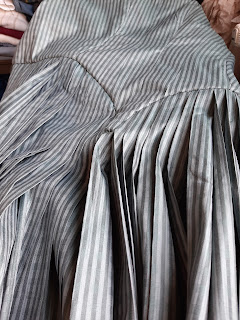It is done.
Finished. The test of the Aidah Gown by Scroop patterns and
Virgil Fine goods.
Since this was a
test, I was concentrating on sewing, and did not take many pictures.
Let me just talk
about the points that caused me concern, trouble, or needed extra
concentrations.
First of all, it
is a great pattern, I've seen the testing on many different shapes, bodies,
fabrics, and all worked out great. My concerns/troubles/extra attention needed
was caused either my body not being a standard one, and/or by being stupid
blind (more about on that later). The bodice itself was pretty straightforward, though
I did the full mock up on straight grain, and then realizing that I did the red
dress's front on the bias. (looking at the existing pieces, we can find both versions).
Discussing it with Leimomi, I decided on a somewhat
off grain, but that still threw of the fit, I had to change back the front
curve. Then I did the sleeves. Oh the sleeves.

I spent three day in sleeve hell. The truth is, I like
to think about myself that while I am not that good at drawing patterns, and I
am mediocre at fittings, I am pretty good at techniques (taking a chance of
sounding full of myself, unless it is really technically tricky, the drawn up
pattern is enough for me, I don't really need to read the instructions -I did
for this pattern, the problem is not that.) I don't remember ever having
problems with sleeves. Sleeve-hell, sleevils were words without any meaning for
me. So, I think the sewing gods decided to teach me a lesson... Anyhow, I cut
the sleeves as per pattern, tried it, as Leimomi pointed out it was a tiny bit too wide at the
cuffs, so I took them in a bit, tried again - almost perfect. So I cut out the
actual fabric, but following our discussion about grainlines, since I wanted my
dress to have a bit earlier "feel" (reflecting more the beginning of the given time-period, than the end), I decided to cut the sleeves
instead of parallel to the warp, cut it with crossgrain. And the sleeves DID
NOT FIT. They were too tight. I really did not understand, I checked, I did cut
exactly the same size as the mock up (took apart the mock up, and I used its
pieces for pattern). Only after banging my head for a while, I thought of the
fact that warp is usually a lot less flexible than weft. I shoud have known. I
spin yarn and weave, I know how the texture of a fabric works (ask me one about
the shirt of Father Ralph in Thornbirds LOL), I learned about textile structure
in my technical school. DUH. And that was the only thing that changed,
grainline, the warp across the sleeve (and not along the length) was enough
that the sleeve did not snuggled up to my arm, but resisted it... I took one of
the sleeves apart, added a cm, cut it out and sewn it up again, now had three
sleeves. Then I spent two more days, because I mixed them up and tried to fit a
left sleeve into a right armhole (yeah, I am a blind idiot). Took me many
tries, (yes, there was some crying, I cantdothis, and threwing into a corner as well), finally realizing what is wrong, and pinning the right sleeve to the
right armhole. Then, so the sewing gods could make sure to make fun of me, after struggling for days -emntirely my fault- Anna brought her jacket to rehersal, because hse could not fit her sleeve into her armhole... and I pinned it in for her in like two minutes.
The next hurdle
was the pleating. My red dress had cartridge pleating, because… just because I
like it, and because the Belgian original one I based my dress off, had one,
but I know all too well, that knife pleating is much more common in the 18th
century than cartridge. So I tried to figure out how many, and how deep pleats
I needed to have to fit the skirt into the allotted place. Yeah, I know, there
are tutorials and lessons on calculating
pleats, but hell, I am a philologist. I avoid calculus if I can get away with
it, even if it means pleating 4,5 meters of fabric into a 60 cm wide space.
Five times.
Sewing the skirt
to the bodice was also different, than my red dress, there I cut out the space
for the V shape of the waist and the top of the cartridge pleats were sewn to
the bottom edge of the bodice…
here I fitted the top of the skirt to a straight
waistline, cut it open in the middle –which was not scary at all… not, not as
scary as hell. Right. It was. but it looks like this on the inside.
Finally it was
done, it fitted, and all I needed a petticoat and some decorations. It really
seemed a good idea to have a ruffled petticoat for the dress… until I realized
that it would mean hand-sewing 9 meters of hem instead of 4.5. But I did it literally
in one sitting. A long sitting
consisting the second half of the first season of Carnival row, but one
sitting, nevertheless. How did I stand up afterwards, you don't want to know.Then I only needed to make like 6 meters of ruffles for decorating, easy-peasy.
Even sewing the line of gathering stitches with the machine, it took me hours to pull the thread and arranging the ruffles more or less evenly. Added a line of silk ribbon to the ruffles, just to emphasize the greenness of the fashion fabric.
When all it was done, I still whipped up another petticoat, as though I have a white one I made for the red dress, according to the consensus of the 18th century sewing group of Facebook, the more, the better, and with this different kind of green striped one, I can still pull another look, if I want to.
So, what do I
think of the pattern? I already said it is really great. I love the back with
its narrow panels (though it works with wider ones too, if the pattern of the fabric would require that). I love that it has a front that is the same style as the
dress I want to recreate (a bit later). I love that practically all of its
component can be exchanged with the Angelica gown’s components. There is
actually a lengthy blogpost about the similarities and differences of the two,
so go and read if you cannot decide.
I also know that
my dress has its faults, but that is most probably originates with my stupid
struggles of the sleeves, and getting tired of taking them out yet another time.
In addition of
adding a cm to the seams (because of the cross-grain), I ended up taking off
about a cm from the sleevehead (as the sleeves were way to puffy). I also
should have only added that centimeter to the lower half of the sleeve and not
to the back of my biceps. I also should have taken the shoulder straps off one
more time, and change its angle a bit more. (As a child, I was a swimmer first,
then a rover, and I have a slight sway-back. Great combo, until you try to fit
something on me. Especially, when yo live with two man who are terrified of sewing pins -so no help with fitting.)
As for sewing, I
would use lining fabric with even more hold, than the cute little polka dot
linen had. The flaps would certainly benefit from them.
The instructions
for sewing the pattern –in fully authentic historic manner- are plentiful in
the patterns. I’ve seen the revised final ones too since, they are even better.
For me one of the difficulties was to adhere to the instructions as much as I
could, because it was a test, after all.
The other thing I would change, I would include either instructions for either (mostly) machine sewing, or at least ideas, where could one cut at least some corners with machine sewing, but I understand that being such a complex pattern with as many sizes as it comes in, it would be difficult (even longer process) to include that too. However, if you want to save time, and would want to use machine sewing at least at some places, ask away, I will gladly give ideas.
Was it worth
doing the test? YESSS! It was a challenge to do it on time. Would I buy the
pattern (even though I do have the Angelica)? YESSS! (in fact I am actually
glad I did the test, because I did not have to wait for the pattern to be
published, ny fingers were itching to do it.)Would I do another test? Well, that depends.
It should be something I really, really want to make, to make it worth for me to do something on time, adhere to instruction, etc, though admittedly I loved being part of the group, sewing people doing it on Instagram, and go “yess, I do that too, what do you thing about this or that?” and kind of sorry to have it end.
But definitely NOT sorry to have a new gown.
A varrós képek a telefonomról.


























































